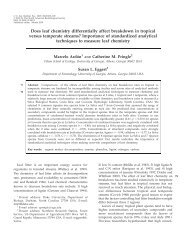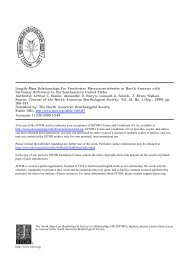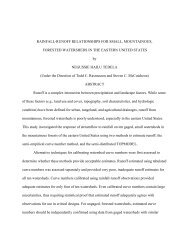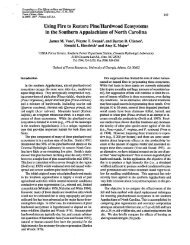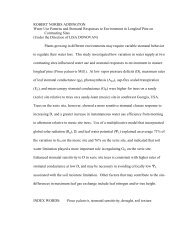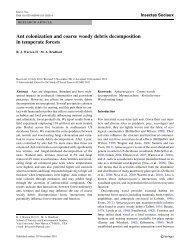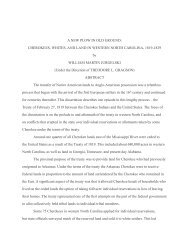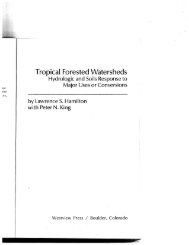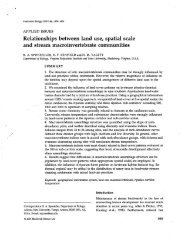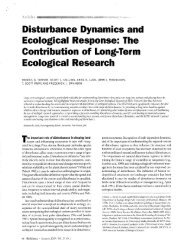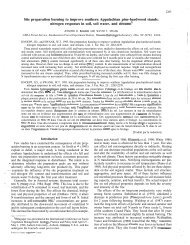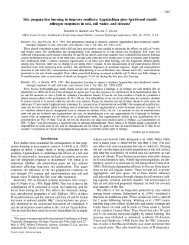biology join - Coweeta LTER - University of Georgia
biology join - Coweeta LTER - University of Georgia
biology join - Coweeta LTER - University of Georgia
You also want an ePaper? Increase the reach of your titles
YUMPU automatically turns print PDFs into web optimized ePapers that Google loves.
Table 2. Cryosphere processes at US Long Term Ecological Research (<strong>LTER</strong>) Network sites and related <strong>LTER</strong> sites.<br />
Site Abbreviation Record<br />
Continental<br />
glacier<br />
causes and consequences and needed adjustments <strong>of</strong> monitoring<br />
approaches to catch signals <strong>of</strong> previously unmonitored<br />
or unanticipated system behaviors. Here, we present<br />
some notable examples <strong>of</strong> ecological and biogeochemical<br />
changes in response to cryosphere loss.<br />
Changes in populations and trophodynamic implications. Decadalscale<br />
declines or distributional shifts in snow- and icedependent<br />
species are now extensive and well documented<br />
(Chapin et al. 2005). When ice-dependent species suffer<br />
habitat loss, the changes in frozen habitats (glaciers, sea<br />
ice, snowpacks, and permafrost) impose both bottom-up<br />
and top-down forcings on terrestrial and aquatic ecosystems.<br />
Ice loss affects ecosystems directly through the loss<br />
<strong>of</strong> physical habitat and through alterations in thermal<br />
conditions and indirectly by altering light and nutrient<br />
supply to primary producers. Both Arctic and Antarctic<br />
sea ice harbor a resident microbial community <strong>of</strong> diatoms,<br />
other phytoplankton, bacteria, and protozoan grazers that<br />
contributes to the total primary production <strong>of</strong> polar seas.<br />
Like sea ice, ice and rock glaciers are habitats for specially<br />
adapted species that may disappear as glaciers retreat and<br />
their cold, glacier-fed streams disappear. The American pika<br />
Alpine<br />
glacier Sea ice Lake ice<br />
Continuous<br />
permafrost<br />
Discontinuous<br />
permafrost<br />
Seasonal<br />
snow<br />
McMurdo MCM 1 1988–2009 X X X X<br />
Arctic Tundra ARC 1 1988–2008 X X X<br />
Niwot Ridge NWT 1 1952–2006 X X X X<br />
Bonanza Creek BNZ 1 1988–2009 X X<br />
Palmer PAL 1 1989–2010 X X X X<br />
Loch Vale LVW 2 1993–2008 X X X X<br />
Marcell MAR 1961–2010 X<br />
North Temperate<br />
Lakes<br />
NTL 1 1978–2010 X X<br />
Hubbard Brook HBR 1,3 1964–2007 X<br />
Harvard Forest HFR 1 1964–2002 X<br />
Kellogg KBS 1 1988–2010 X<br />
Shortgrass Steppe SGS 1 1969–2010 X<br />
Sevilleta SEV 1,4 1991–2010 X<br />
Articles<br />
Fernow FER 3 1951–2007 X<br />
Konza KNZ 1 1982–2011 X<br />
Plum Island PIE 1 1950–2004 X X<br />
<strong>Coweeta</strong> CWT 1,3 1950–2009 X<br />
Baltimore BES 1 2000–2009 X<br />
Andrews Forest AND 1,3 1957–2007 X X<br />
Jornada JRN 1,3 1983–2009 X<br />
Olympic OLY 5 1962–2009 X<br />
Transient<br />
snow<br />
Note: The superscript number next to the abbreviation refers to the sponsoring agency for that site: 1, US <strong>LTER</strong> Network site; 2, US Geological Survey<br />
Water, Energy, and Biochemical Budgets site; 3, US Department <strong>of</strong> Agriculture Experimental Forest and Range site; 4, National Wildlife Refuge; 5, State<br />
Experimental Forest. Record refers to the length <strong>of</strong> the air-temperature record used to estimate frost and freezing duration at each location.<br />
(Ochotona princeps)—although it is not as well known or<br />
charismatic as penguins or polar bears—is attaining new<br />
status as a poster child for glacier loss and climate change.<br />
Pikas do not hibernate and use subsurface microclimates<br />
in rocky debris to persist where surface conditions would<br />
preclude their survival. Despite this adaptation, some local<br />
pika extinctions in the Northwest have been linked to cold<br />
exposure caused by a loss <strong>of</strong> insulating snow cover (Ray et al.<br />
2012). Permafrost thaw also results in habitat disappearance<br />
for its resident species. Because permafrost occurs in so<br />
many different habitats in different stages <strong>of</strong> development,<br />
its loss may trigger primary or secondary successions.<br />
Widespread past and projected future reductions in<br />
snow-cover extent, duration, depth, and water equivalent<br />
can also have extensive ecological repercussions. Many plant<br />
and animal species are adapted to snow-cover conditions<br />
and will perish if they are unable to migrate or tolerate<br />
less snow cover. Even so, not all animals that live in cold<br />
environments respond negatively to reductions in snow<br />
cover. For example, ungulates such as white-tailed deer,<br />
mule deer, elk, and caribou expend less energy and are less<br />
susceptible to predation when snowpacks are shallower.<br />
Some <strong>of</strong> the species most susceptible to snow-cover loss<br />
www.biosciencemag.org April 2012 / Vol. 62 No. 4 • BioScience 409



